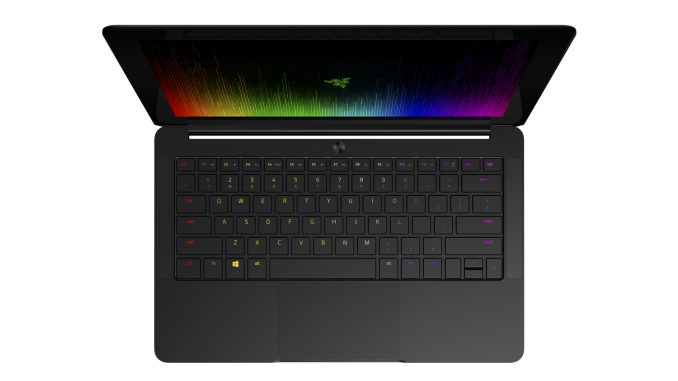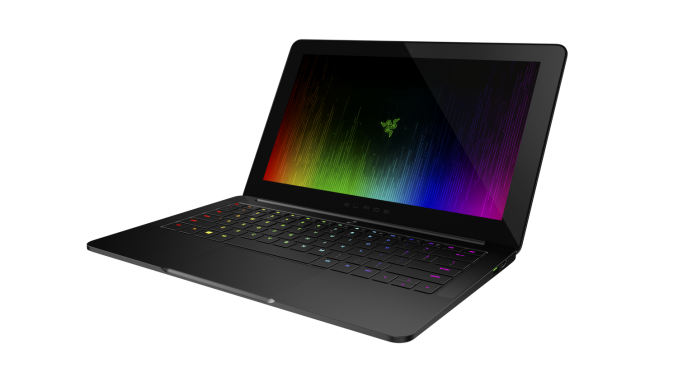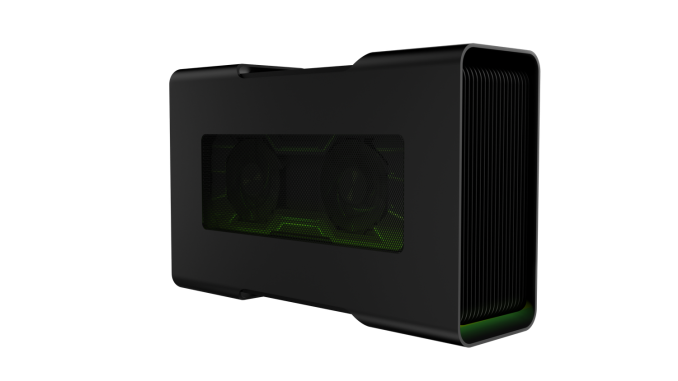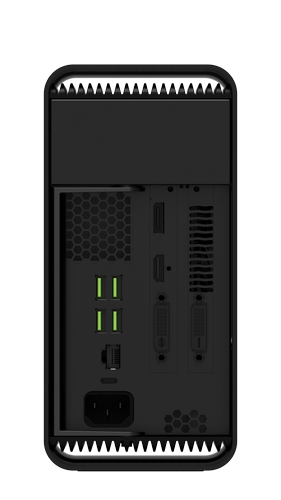Razer Launches The Razer Blade Stealth Ultrabook And Razer Core At CES 2016
by Brett Howse on January 6, 2016 9:01 AM EST- Posted in
- Laptops
- Razer
- Trade Shows
- CES 2016
- Razer Blade Stealth

Today we have some news that is kind of unexpected. Razer, the company known for gaming peripherals and gaming laptops such as the Razer Blade, has decided to enter the Ultrabook market with the launch of the Razer Blade Stealth. Not only is an Ultrabook not something expected from Razer, it is also priced very competitively and undercuts the competition on price.
Razer did not cut any corners either when designing the Stealth. Just like it’s more powerful and higher priced siblings, it is built out of a CNC-milled aluminum chassis, which is a designing feature of Razer laptops. But despite the solid frame, the laptop is still only 0.52-inches thick and weighs in at just 2.75 lbs. On the styling front, it keeps the black finish of other Razer laptops, but also outdoes them with a full “Chroma” keyboard with individually lit RGB keys. I’ve been hoping that they would do this for a while when reviewing the Razer Blade, so it’s great to see the RGB keyboard come to the Stealth model.
The 12.5-inch display comes in two options. The base model is a QHD (2560x1440) resolution, but you can also opt for a UHD (3840x2160) model with full Adobe RGB color gamut. I need to check in with Razer on how they are going to handle the wider color gamut, and will let you know after we get some hands-on time on the show floor.
The Stealth, as an Ultrabook, is going to be powered by Ultrabook class components, which in this case is the Intel Core i7-6500U processor. This Skylake chip features two cores, hyperthreading, and a base/turbo frequency of 2.5 GHz / 3.1 GHz. I was hoping that Razer would also offer a model with Intel’s Iris GPU, but that won’t be the case, at least at launch. The only memory option is 8 GB of LPDDR3-1866, and storage options range from 128 GB to 256 GB of PCIe storage on the QHD model, and 256 GB to 512 GB on the UHD model. The battery life will need to be tested, but the laptop has a 45 Wh battery, so it’s not going to be class leading in that regard.
For connectivity, the Stealth will have two USB 3.0 ports, and a USB 3.1 Type-C connector with Thunderbolt 3 support. The Thunderbolt is a key component to the Stealth, thanks to the accessory that Razer is also launching.
The Razer Core is a Thunderbolt 3 connected external GPU, which also acts as a docking station for the Stealth. With a single cable connection, the laptop can power an external display, all of the docking connections with four USB 3.0 ports and Gigabit Ethernet, and support for a 375W GPU.
The Core features a built-in 500W power supply, and the GPU support is for any single card which is full-length and double-wide, which means pretty much any GPU out there. The Core also features two additional Chroma lighting zones so that you can tailor it to your liking.
Razer has not yet announced any updates to the Razer Blade or Razer Blade Pro, but I would expect that both of these will also feature support for the Core when they do get their next refresh.
The Core supports plug and play with validated graphics cards, without the need to reboot.
The addition of the Razer Core brings back some of the gaming performance that Razer has been known for, although with a U series CPU it will be interesting to see what level of GPU is required to become CPU bound, especially with DX 12. If we can track down a review unit, we’ll try to sort that out.
The Razer Blade Stealth will be on-sale starting today, with a starting price of just $999. Considering the high resolution panel and Core i7, this undercuts most, if not all, of the Ultrabook competition on price. The top end 4K model with the UHD display and 512 GB of storage will be $1599.
Source: Razer















84 Comments
View All Comments
WinterCharm - Wednesday, January 6, 2016 - link
Well, before TB 3 Intel hadn't pledged support for external GPU support. Now that we have support. And widespread thunderbolt adoption thanks to its integration into the USB Type C port, we can see things really progress.schizoide - Wednesday, January 6, 2016 - link
THIS one is manufacturer-agnostic. It isn't like the Alienware Amplifier. This will work with ANY computer with a TB3 port that supports intel graphics switching in the BIOS.On windows 10 anyway, it's unclear if OSX will support it. I sure hope so.
tipoo - Wednesday, January 6, 2016 - link
I'd be using Boot Camp anyways, as under OSX I lose 30-50% of my GPU performance under native OpenGL vs Windows DX11-12.Solandri - Thursday, January 7, 2016 - link
It doesn't have to be Thunderbolt. If you're willing to sacrifice your laptop's wifi slot, or if it has a mini PCIe WLAN card slot with enough lanes, or an ExpressCard slot (really sad these have been phased out of notebooks), there's an adapter you can buy. It just maps the mPCIe connects into a regular PCIe slot. Pop in a regular graphics card and you're in business.http://www.amazon.com/Laptop-External-PCI-E-Graphi...
ingwe - Wednesday, January 6, 2016 - link
Wow this is amazing! I feel like a lot of people have been interested in something very similar to this. I hope it sells really well so that the rest of the industry takes a hintImSpartacus - Wednesday, January 6, 2016 - link
I almost would've preferred a dock for the laptop that contains additional cooling equipment (just fans against the chassis) and the gpu in one package.Firstly, you don't waste time with thus kind of complex setup unless you're looking to pair a big gpu with your laptop.
Therefore, If I'm gonna try to power 375W of gpu muscle with a 15W cpu, I want that cpu to be able to maintain an aggressive turbo during extended gaming. You need some kind of supplementary cooling to enable that.
I trust that two Skylake cores are enough, but they have to be able to maintain an aggressive clock speed to keep up with a beefy gpu.
WinterCharm - Wednesday, January 6, 2016 - link
Razers cooling design likely takes this into account without the need for additional external cooling.ImSpartacus - Wednesday, January 6, 2016 - link
I hope that's the case. Razer has historically done pretty well with that and I hope the Stealth is no different.DanNeely - Wednesday, January 6, 2016 - link
Since they're not using a proprietary connector I think making it something that should work with any TB3 device (including whatever their next laptop chassis looks like) is the right option. You can always buy $20 cooling pad if you need it separately. You might not though; my XPS13 is able to maintain max turbo on its 15W skylake running Einstein@Home 24/7 on the CPU. (Buggy openCL drivers mean I'm not running anything on the GPU; but E@H's GPU tasks only occasionally dropped the clock down 100mhz when I tested them.)ImSpartacus - Wednesday, January 6, 2016 - link
That's probably a good point. If this is as versatile as it should be, then I sorta get why Razer wouldn't want to lock into a particular laptop.